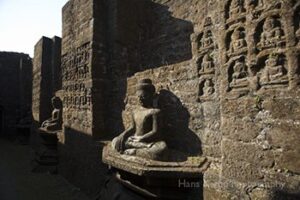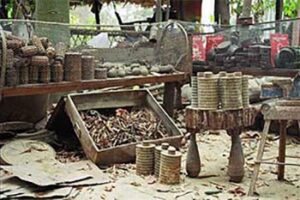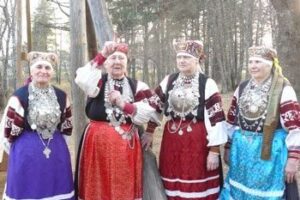
In The Land of High Passes: In Ladakh, rough roads and dramatic vistas
By Manjusha Gupte
The advance jeep scuttled sideways before fishtailing towards the cliff edge. No guard rail. A sheer fall to the valley floor.
At 13,000 feet, I watched my parents and husband slide out of my life in slow motion. My companions screamed in horror, then the SUV careened to a halt… at the lip of the precipice.
Folks tumbled out, unscathed. It was only day one of our 300-mile trans-Himalayan road safari. Running from Manali to Leh in northern India at an average elevation of 2.5 miles, this highway is considered one of the most dangerous in the world. And it was living up to its reputation.
Disembarking from the vehicle now lodged in the morass, Mac, my husband, engulfed me in a bear hug. All six American friends shook their heads in disbelief. They were ready for excitement when they signed up for this trip, just not so much so soon.
My parents and I – veteran adventure seekers in India – had undertaken this venture before, so we had split the experienced members between the two jeeps.
Meanwhile, the stuck vehicle created a traffic jam and required the manpower of a dozen to pry it free of the bog. The driver seemed unfazed, laconically remarking, “It gets worse ahead.”
I noticed a couple of my friends invoking higher powers… perhaps regretting their choice of the overland route versus the more popular (and now seems more sensible) short flight from Delhi to Ladakh.
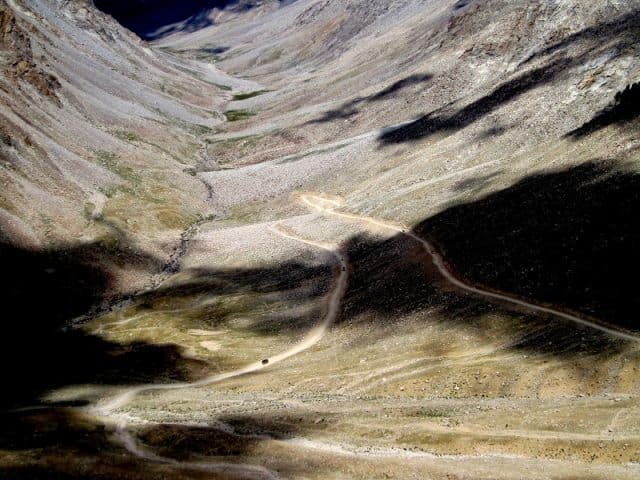
The Manali-Leh highway is passable only four to five months of the year. In the open season, exhaust-belching trucks ply its length, often at break-neck speed… more sorties translate into higher revenues. The vestiges of the unlucky ones lie scattered in the vales below. Pithy maxims plastered on rocks proclaim — ‘Haste makes waste.’
Around us gangly conifers gave way to dwarf-shrubs and scrub-grass — we were well above the tree-line. In the sky, lammergeiers (bearded vultures) glided with the thermals. A solitary yak (long-haired bull) foraged in the distant meadow. Behind him, smoke-spirals signaled a village.
Nothing soothes frazzled nerves like a cuppa, so after rescuing our second vehicle, our convoy pulled over at a mountain hut. A parched-faced matron poured boiling tea into our mugs. It tasted sweet and buttery… the distinctive flavor of yak-milk. Her little twinkle-eyed daughter watched from behind the door.
They both giggled at our attempts to stand and walk. The rarified air had cast its spell — we were comporting like drunkards. Even simple tasks seemed daunting to our fuzzy minds.
My focus drifted, recalling my last trip through this hamlet, ten years earlier. We stumbled upon the Dalai Lama’s motorcade, returning from the Kardang monastery in Keylong. I remembered the black cars trundling through swirling dirt-devils, the inhabitants lining up to catch a glimpse. This time no spiritual leaders manifested, so we stocked up on cookies since there were no permanent settlements for half the length of our route.
That night we slept low at Jispa (a mere 10,500 feet), but sledgehammer headaches and churning tummies signaled the elevation. Mac turned into a raging lunatic, stomping around towel-clad, demanding hot water. His frozen extremities were too numb to discern the temperature and his oxygen-deprived brain too addled to listen to reason. We put him to bed under a pile of comforters, letting Diamox (acetazolamide) speed up his acclimatization.
Our expedition organizer, Khemraj Thakur, had insisted a third vehicle carrying an inflatable oxygen chamber and thermal jackets accompany us, in event of an emergency. Thankfully, we didn’t require its services — it remained a benevolent presence watching over us.
Blacktop Peekaboo
As we traversed the cordillera, the blacktop played peekaboo, disappearing into streams, sand dunes, and landslides. We entered Ladakh at Sarchu, its vast emptiness beguiling the mind. In a country of a billion-plus, this desolate expanse seemed disorienting. Ladakh means the land of high passes, our driver Dai explained, as he shifted into a lower gear, readying the vehicle for a steep ascent. The road turned into an escalator – 21 hair-pin bends of the Gata Loops whisked us up 3,280 feet in 6.2 miles.
We arrived in the Ladakh high desert, where the Greater Himalayan massif blocks the clouds from crossing over, creating a rain-shadow effect. The barren mountains ran a gamut of colors – yellow, orange, red, pink, purple – competing with a rainbow.
They formed the base material of the Indian plate, which collided with Eurasia to create the world’s highest range – more than a hundred 23,000-foot peaks (In comparison, Andean Aconcagua at 22,841 feet is the tallest mountain outside Asia; North America’s Mt. McKinley measures 20,322 feet).
Stretching for 1,500 miles, the young chain is slowly inching skywards, tumbling over itself. Today, rumbling earthquakes and sliding slopes showcase its growing pains.
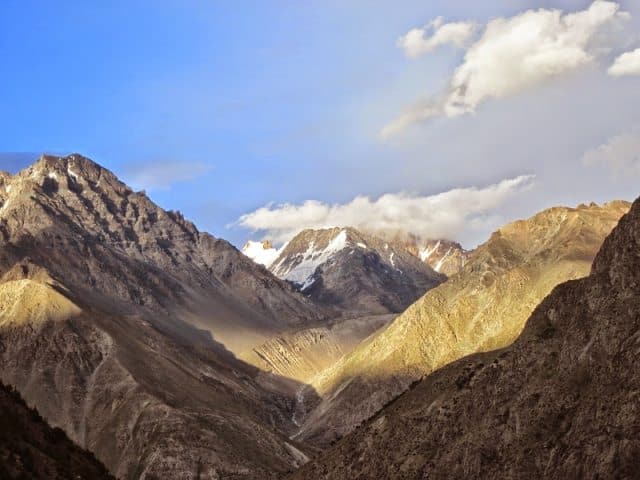
We were stopped at a police checkpoint — road construction, they explained. Then an ominous roar reverberated, bouncing off the valley walls. My friends peered out of the windows anxiously, catching sight of dynamite and blasting wires.
Around mid-day, we spotted Changpa nomads herding their goats. A shepherd shearing his flock let us touch the wool – pashmina, the softest cashmere, so delicate that it has to be hand-woven.
We were soon bounding after the frisky animals; it seemed as though we were chasing clouds. We plodded ten yards before gasping for breath, lying flat on the ground, our hearts thumping, my runner husband groaning in anguish.

Ladakh lived up to its name. We crossed the Zanskar range through Tanglang-la (pass) at 17,582 feet. These mountains exhibited sediment from the ocean floor, harking back to their marine origins. The vehicles strained to push uphill. Dai slammed his hand on the steering wheel and braked suddenly – a flat tire.
Nonchalantly he gestured “puncture” to our other driver, who pulled over to assist. Soon, a couple of truckers stopped to lend a helping hand. It was the brotherhood of the high-altitude drivers. Removed from civilization, they relied on each other in emergencies. Chatting amiably about road conditions and weather, they tightened the bolts on the spare. We watched in amazement, for we could barely stand straight, our lungs straining to take in the thin air.
As our group rolled down the north slopes, the ochre landscape gave way to flecks of green. Water brought life and agriculture back to the fold. The pearly gray Indus River dashed down from the icy highs of Tibet to meet the Arabian Sea.
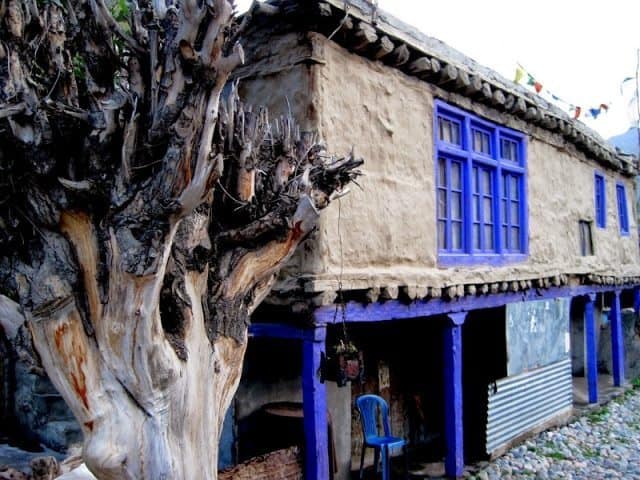
The Ladakh range, dotted with gompas (monasteries), stood sentinel over the wide Leh valley. On the hillsides, vivid prayer flags (colored cloth rectangles strung along a thread) rustled in the wind, bestowing benediction, while in the streets below, prayer wheels twirled generating good karma. Maroon-robed monks clutching cellphones scurried along for the evening service. The smell of butter lamps pervaded the air. I took a deep breath, inhaling the familiar scent.
Braving treacherous terrain and altitude sickness, our motley expedition had finally made it, in one piece. Arriving here by air — from the flats of Delhi to sky-hugging summits — would have been a shock to the system, physically and mentally.
We would have gone from 700 feet to 11,500 in 80 minutes; our minds and bodies experiencing no transitions. Journeying through the Himalayan ranges and peering into their depths left us humbled — we appreciated the tectonic forces that forged continents and deposited marine fossils on alpine peaks.
That night, huddled over warm beers with tomato-red faces and flaking skin, our troop recounted its adventures. In retrospect, these reminiscences assumed humorous undertones. “Remember the road above and below us was still being built as we drove through it,” Debbie recalled mirthfully.
Striking a somber note, Mac, the fittest person in our group, admitted, “This is probably the hardest road trip I have undertaken…the altitude felled me…made me realize the limits of my physical endurance.”
This wasn’t merely a journey about traversing the Himalaya in Ladakh, it was also one of overcoming the mountains of the mind. There were inherent dangers in this safari. But the exhilaration more than made up for it. In the end, we had no regrets about the flight not taken.
Manjusha Gupte’s love affair with the Himalaya began at age 13 on a trek to the source of the Ganges River. She continues hiking mountains big and small, currently living in the backyard of the Oregon Cascades.
- Missouri Sports Travel Adventure: From Landmarks to Ballparks - January 21, 2026
- What First-Time Visitors Get Wrong About Visiting Iceland - January 15, 2026
- Bareboat Charter vs all-inclusive Crewed: Which Luxury Charter Fits You? - December 29, 2025


